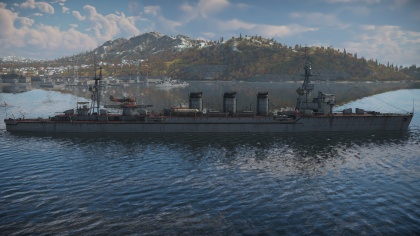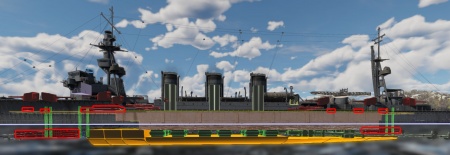IJN Tama
Contents
Description
The Kuma-class, IJN Tama, 1942 is a rank Japanese light cruiser
with a battle rating of (AB), (RB), and (SB). It was introduced in Update 1.89 "Imperial Navy".
General info
Survivability and armour
IJN Tama is the weakest light cruiser when it comes to taking enemy fire, being unable to repel anything but destroyers in a direct, short-range gun battle. On top of having the lowest crew compliment among cruisers, it suffers from one major weakness: ammunition explosions.
Both: First-stage ammo stowage and its main ammunition storage (Charge/Shell/Ammunition storage rooms) are exposed to direct enemy fire. The main storage is somewhat protected by the 44.6 mm plate above it, however, it's above the waterline, allowing for lucky shells to get unimpaired into one of the rooms and blow it up. If the crew did not suffer particularly many casualties beforehand - ship can survive, however, such a blow is extremely severe, turning what otherwise would be a fresh ship, into a burning husk rapidly taking water in.
Moreover: The citadel armor is the weakest among cruisers, amounting to only mm RHA. While on paper Emden, 1944 has only mm, it's just for an internal plate, with a second 50 mm plate in front of it. Under battle conditions this gives her much better protection, in particular at a point-blank range, where she's completely immune to Kuma's 140 mm type 2 SAP shells. Kuma's citadel armor is enough to deflect only secondary armament (such as 3-inch Mark 10), HE shells from the main guns or certain low-penetration AP shells at a high angle of attack (such as 180 mm/60 B-1-K's PB-32 SAPCBC shell at angles of over 72°, or Kuma's own 140 mm type 2 SAP shells at any angle).
Mobility
Write about the ship’s mobility. Evaluate its power and manoeuvrability, rudder rerouting speed, stopping speed at full tilt, with its maximum forward speed and reverse speed.
Armament
Primary armament
Kuma has above-average sustained firepower for its BR when firing a broadside of 6 guns from the first-stage ammo stowage, even despite ship's individual guns being sub-pair when compared with an armament of the ships in the same BR. As a consequence she as the worst firepower directly in the rear and ahead. Especially given an extremely narrow-angle where 3 turrets firing ahead can simultaneously shoot at the same target, while at the rear she's covered by just a single 140 mm gun.
Guns have an acceptable reload speed and the second-best turning speed in its BR, though they suffer from one of the worst shell velocities among counterparts. Good horizontal guidance of the turrets allows her to fire most of its guns at a relatively steep angle of approach, minimizing exposed silhouette. That said though, once receiving all mobility upgrades, the ship will have an issue with roll exceeding negative vertical guidance of the turrets during the turns at high speed, making it impossible to engage targets at any range, often for significantly more than the full gun reload time.
Four types of ammunition are available, with HE shells being the only one open without any modifications unlocked:
- type 0 HE - Primary type of shell, useful against all targets at all ranges. It's relatively good in fighting enemy ships of all types, primarily thanks to its good chance of igniting enemies. When fighting heavy cruisers with HE, shells should be fired at the superstructure whenever possible to prevent shells from being nullified by the armor.
- type 0 HE-DF - Time-fuzed anti-aircraft shells. Their usability is highly situational due to the vertical guidance of just +20° that prevents effective engagement of anything but torpedo bombers.
- type 2 SAP - tier 1 modification, it offers a larger explosive payload comparing to the type 1, though its penetration is usually insufficient to engage armored parts of enemy cruisers at anything but the point-blank range. It's useful primarily against unarmored targets, such as most of destroyers.
- type 1 SAPBC - anti-cruiser semi-armor piercing shells, with increased penetration for the price of explosive payload. Though even with that increase, it will still struggle against heavy cruisers, or even citadels of a certain light cruisers at range. Still, though, it is typically the primary shell type to be used against heavier enemy warships.
Secondary armament
Dual-mount secondary 25 mm guns are positioned on sides of the first funnel. They have relatively good firing arcs, both: horizontal and vertical, although rarely able to bring both emplacements firing at a target at the same time. Realistically speaking those are the primary anti-aircraft armament of the ship.
That said though - they are still an exceptionally poor anti-aircraft weaponry, the worst among cruisers of all nations, being able to take down only the least cautious enemy airplanes. Similarly, when faced with enemy boats - using primary armament to take them down is always a vastly superior solution, even when manually controlling the guns.
Anti-aircraft armament
Next to the bridge superstructure there are located two 7.7 mm machine guns. They play a support role against hostiles below 1 km range, that said though: Within its BR those guns provide an insignificant amount of firepower, being nothing more than a nuance to the enemy.
Torpedo armament
Kuma comes with an unusual type of torpedoes for a Japanese warship. Its wet-heater Type 6 torpedoes are the worst torpedoes one can find one a Japanese Capital Ship, featuring low damage potential, slow speed, and a relatively short range (although that gets alleviated by the Torpedo Mode). The notable upside of the ship is the fact that she carries a full reload of torpedoes, allowing for surprise attacks and exploiting opportunities more than once during the battle.
Stock
When stock, with just 7 km range at the speed of 65 km/h, the usefulness of torpedoes is limited pretty much only to short-range counter-torpedo activities, or late-match encounters. That said though, ideally, torpedoes would be used only as a defensive measure, dropped between main gun salvos or during the turns, as typically hostile ships will have ample time to avoid while themselves having faster and more potent torpedoes.
Torpedo Modification
Once equipped with a torpedo modification it increases range to 15 km at the price of decreasing speed all the way down to 48 km/h. Use cases extend to an area-denial, taking down less aware cruisers or AI-controlled units, notably Cargo ships. The very slow speed, however, is a significant challenge, as sometimes you'll find even cruisers easily avoiding hits, with the barest adjustments of course making it impossible to score hit by the time torpedo actually arrives at the target location. Hitting a destroyer with torpedoes after the modification boils down mostly to luck or failure of the enemy captain to first change the course and then spot an obvious, slow-moving trails. Typically a wider cone of torpedo spread might be preferable for increasing a hit chance when dropping them against the larger number of enemy ships. Trying to nail a lone warship at a long range is a moot effort.
Special armament
Depth charges, mines, rocket launchers and missiles are also effective in skilled hands and can take an off-guard opponent by surprise. Evaluate the ammunition of this type of armament and rate its performance in combat.
Usage in battles
Describe the technique of using this ship, the characteristics of her use in a team and tips on strategy. Abstain from writing an entire guide – don’t try to provide a single point of view, but give the reader food for thought. Talk about the most dangerous opponents for this vehicle and provide recommendations on fighting them. If necessary, note the specifics of playing with this vehicle in various modes (AB, RB, SB).
Pros and cons
Pros:
- Able to reload torpedoes in battle
- High speed
- Very decent fire power for the main caliber
Cons:
- Poor AA armament
History
Due to the expectation that the Tenryū-class cruiser wouldn’t perform to the satisfaction of the naval command in its role of leader and the appearance of newer and faster destroyer types, with which the Tenryū wasn’t able to keep up with, the shortcomings of the Japanese small cruiser concept became evident. These shortcomings were further emphasized with the advent of the large American Omaha-class light cruiser, capable of easily outgunning the Tenryū-class.
In response to this, Japanese shipbuilders revised Tenryū’s design and developed a new, larger version of the ship with increased speed, range and firepower. This new successor design would become known as the Kuma-class light cruiser. With the design being accepted, outstanding plans for the construction of the four remaining Tenryū-class light cruisers, as well as three other cruisers, were cancelled, while an order to construct five Kuma-class light cruisers was issued instead.
Kuma, the lead ship of her class, was laid down in August 1918, launched in July 1919 and subsequently entered service with the IJN the following year, in August of 1920. Immediately after her commissioning, Kuma was deployed as part of the Japanese intervention in Siberia against Bolshevik forces.
During the early 1930s, Kuma underwent a significant refit and later took part in hostilities during the Second Sino-Japanese War, patrolling off the coast of China and assisting in landing operations.
Following the attack on Pearl Harbor, Kuma participated in the Invasion of the Philippines and would remain stationed there until August 1942. After a brief refit in September, Kuma joined the Dutch East Indies and New Guinea campaigns, being tasked with transporting troops and patrolling the local waters until late 1943.
In January 1944, Kuma came under torpedo attack from the British submarine HMS Tally-Ho, shortly after departing Penang. Kuma suffered two hits, with the resulting damage and subsequent depth charge detonations sealing the ship’s fate. Kuma was later struck from navy records in March 1944.
- From Devblog
Media
Excellent additions to the article would be video guides, screenshots from the game, and photos.
See also
Links to the articles on the War Thunder Wiki that you think will be useful for the reader, for example:
- reference to the series of the ship;
- links to approximate analogues of other nations and research trees.
External links
| Japan light cruisers | |
|---|---|
| Kuma-class | IJN Tama |
| IJN Yubari* | |
| Nagara-class | IJN Isuzu |
| Sendai-class | IJN Sendai |
| Agano-class | IJN Agano |
| Mogami-class | IJN Mikuma · IJN Suzuya |
| * Unique ship | |






